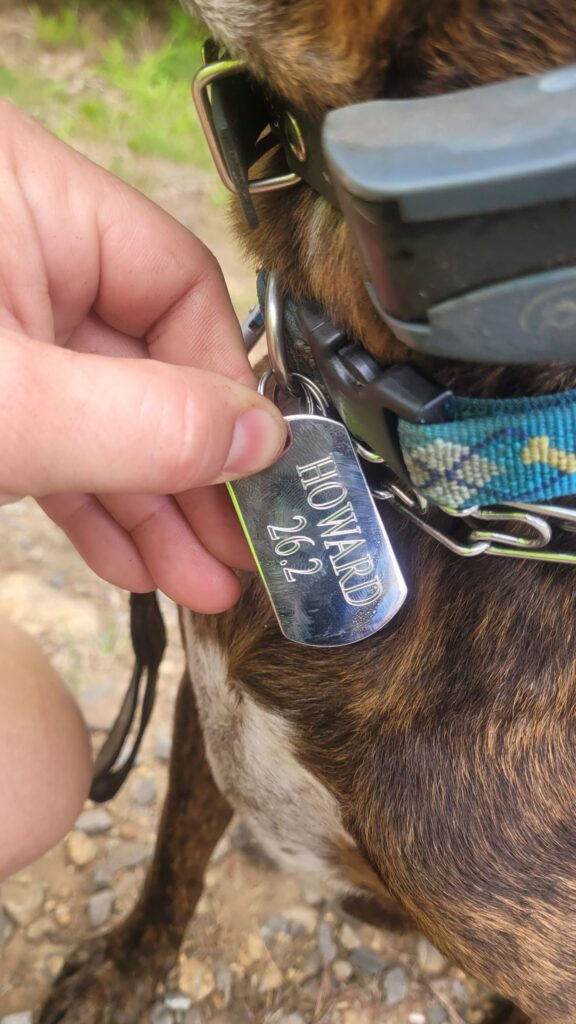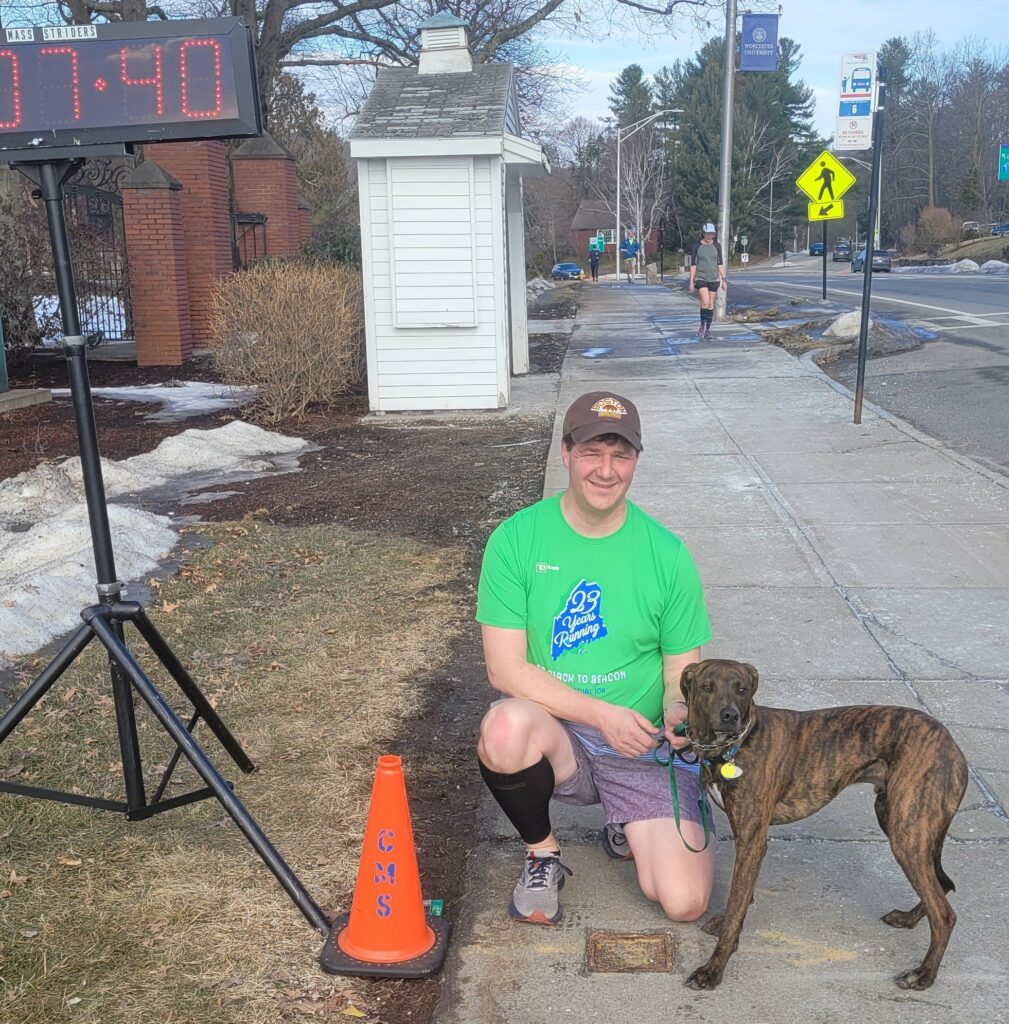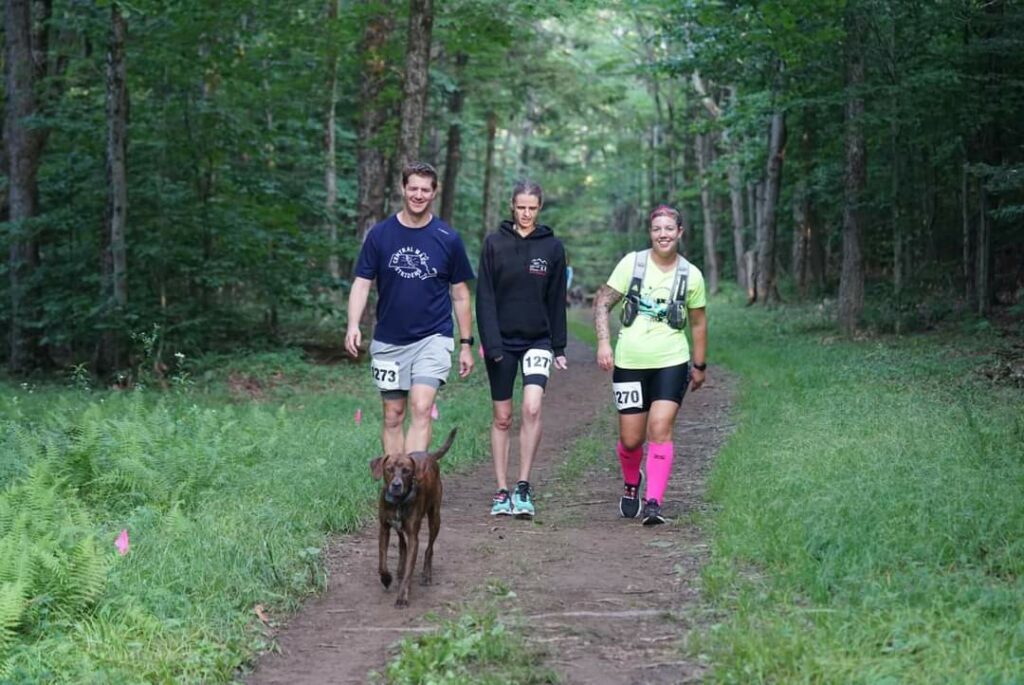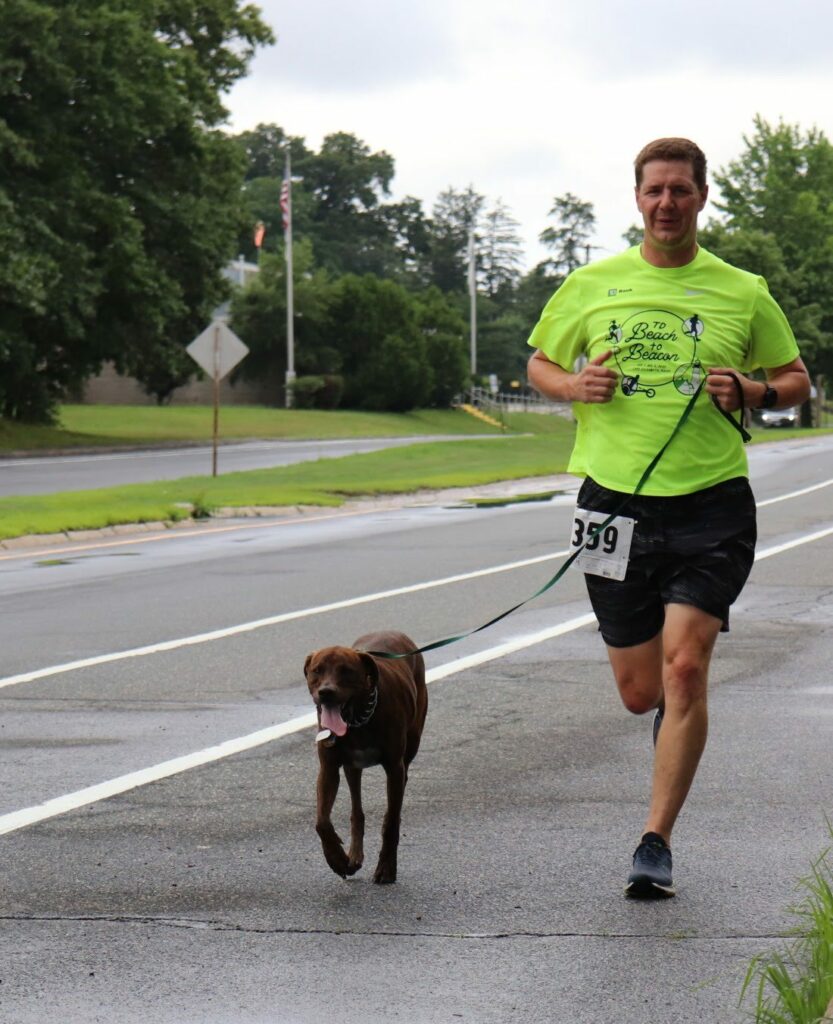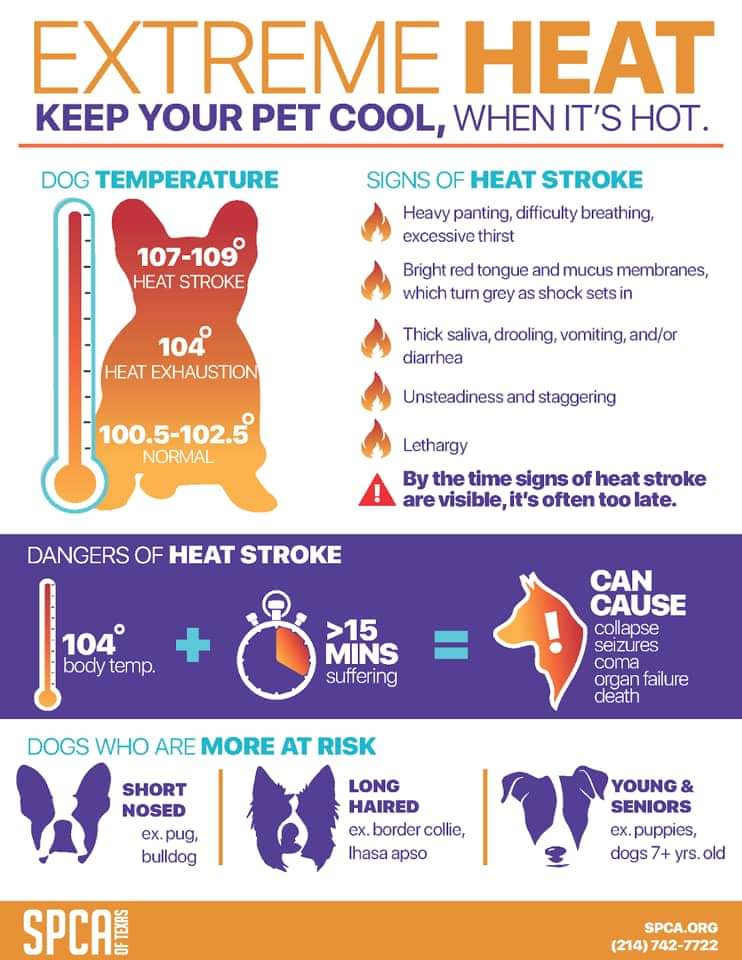Written by Scott Johnson, Dog Dad to Howard
Running with a Dog
“A tired dog is a happy dog!”
Hello Striders, my name is Scott Johnson, and most of you know Howard, my four-legged running buddy. Howard is my third dog that I have trained to run with me, and the first that has been able to go marathon plus distances.
Full disclosure, I am NOT a VET, or a professional dog trainer. Training a dog to be obedient, let alone to run, is a subject with a wide variety of different “how to” opinions. There is no “correct” way to train a dog. Everything I mention below is purely based on my experience (mostly trial and error), and as with most new adventures, a professional should be consulted before bringing your dog out on a run. So, please speak to your vet if you are considering running with your dog more than a typical morning and evening walk. There are some particular safety/health issues that I’m constantly keeping in mind while I run with Howard.
Know your dog. Not all dogs are runners. Hell, some dogs get tired after a 20 min walk and will sleep for the next four hours. Different types of dogs have been bred for different traits over the last few hundred years. If you’re looking to get a puppy as a future running buddy, then look for the Cattle Dogs, Collies, Shepherds, or Curs (Howard is a Mountain Cur/Kerr). Dogs that have high energy need lots of “enrichment” and activity can make great running partners. If you are like me, and only get rescues, then talk to your vet about what breed the dog might be, as they should be able to identify major “breed characteristics” without doing a DNA test. DNA tests are also pretty cheap now a days, so do some research into reputable brands. If you have a dog that does like to run, start slowly with low mileage. Treat building mileage just like you would for yourself going for a new distance; slow incremental gains in distance and speed.
Heat and Humidity. Just like for humans, running in the heat and at a high dew point can be dangerous for dogs. We humans sweat out our excess heat, but dogs do not have this ability. They lose heat through their tongue, which is why dogs pant in the heat. This is an extremely effective method , but it is important to keep in mind that dogs have a higher internal temperature than humans, (100.5-102.5 degrees), but can reach heat exhaustion around the same temperature as humans, about 104 degrees, and stroke around 107 degrees. This does not leave a lot of room for error. A dog that is running, or one that is dark in color, or has lots of hair or fur can have heat exhaustion/stroke happen very very quickly. Make sure you know the signs. This is my greatest concern when running with Howard. Since I run trails mostly, I always plan my runs near water, either lakes or streams. I have a bowl and water in the car for after the run. When running on the roads in the summer, I stay away from the midday runs, and typically don’t go further than 8 or 10 miles (which he has shown to be his max on a hot road runs). Most dogs will slow down and “tell” you that they are done running. Pay attention to their cues and be prepared to walk or find shade if need be. I have had multiple 45 min runs turn into 90min walks due to heat.
Food and nutrition. This one really comes down to preference on brand and what your vet recommends. I use Purina One, but then supplement it with a high protein puppy food, especially a day before, day of, and day after a long run. I don’t give him food every few miles of a long run, or every 30 minutes, like I would myself. Instead, I’ll have a zip-lock with a few high calorie training treats that I’ll give halfway through the run, and usually keep the puppy food in the car that he can eat once the run is over with.
Harnesses and training. This is all subjective to personal taste. Because I wanted Howard off-leash, I used a harness for the first few months, and then stopped once I was comfortable with recall. There are tons of style and functions of harnesses, too many to list here.
Most trainers will stick to one or two of the three main ways of training a dog: Treats (reward-based training), a prong collar (correction-based training) and electronic collar (off leash / hunting training). I use all three methods, with the electronic collar not being introduced until the basic commands are mastered and I’m ready to start off-leash training. If you want to train your dog, find a reputable trainer, with good references, and remember above all, that good dog training is actually training the owner how to be the alpha in the relationship.
Paws. The are two concerns I have when it comes to paws and pads. The first is road running in the middle of the summer, when the ground temperature can soar in the sun. The second is road running in the winter, especially when there is salt on the roads. Both will cause their pads to dry out, blister, or peal. I have moisturizer that I apply to his feet in the summer as needed, and food grade lubricant on his feet and legs in the winter. Dogs that have lots of fur in between the toes and pads, winter trail running in the snow can lead to a build up of snow in the paw. Check the feet and clear out any snow so the dog is running on the pads, and not the build up of ice in-between.
In general, try to run on various surfaces. it will build your dog’s toughness in their feet for the longer distances.
Howard’s Story. I got Howard in December 2021. The adoption agency I used (Forever Home Rescue, Medfield MA) had a description of Howard from the foster family. The first sentence was, “runs three miles with me 5-6 days a week.” That was all I needed to read and picked him up less than week later. The first few weeks were all about building trust, all on leash, learning the basic commands such as Heel, Here, Sit, Stop. I probably didn’t do much more than 3-4 daily miles and only 15 weekly miles with him for a month or two. Even though we started off with low weekly milage, it was obvious he was a distance runner. At 11 months old, his energy level was off the charts and he wasn’t tired at the end of any runs. After 2 months, he had command of the basics, and we started off-leash training, while increasing the individual runs and total weekly mileage. 15 miles per week increased to 20 over a month or so and he was with me for every run at that point. Halfway through 2022, I signed up for my first trail 50k (Stone Cat), and both of our weekly mileage increased up to 30-35 miles with individual runs topping out around 16-18 miles. It was the first 18 mile run that we did (on the Stone Cat course) that I knew he could go beyond a marathon distance. He had his second yearly vet appointment, which was when we added the puppy food to his diet and got the go ahead to keep increasing the mileage. By the spring of 2023, I was training for the Chesterfield Gorge Ultra and my coach had a marathon long run on the plan. So, he and I, with a few of my friends, did out and backs on the Rutland RT for his first marathon in May. He did multiple 28ish mile runs while I was training for my Fall ultras last year, as well as running all three of my 20 mile runs training for Revel Marathon this past spring. To cap it off, he did around 50 miles over 48 hours at the Notchview Ultra last month.
The American Kennel Club is a great resource for different breed types, especially in the temperament, trainability, and energy level description. It’s a good place to start to figure out what breads (or mixed breeds if you go with a rescue) work best for your family. I also follow the “Running With Dogs” group on Facebook. It is a great community, with people always willing to give advice to new running dog owners.
As you might have guessed by now, this wasn’t so much about a Tip Tuesday that is practical to the HCS group as a whole, but more to get Howard’s pictures plastered on the HCS feed to keep Peter happy!!!
Thanks for reading this. Good luck to all training and running fall marathons or ultras.
